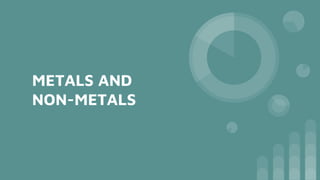
Metals and Non-metals plus one NIOS
- 2. Physical properties of Metals & Non-metals Physical properties Metals Non-Metals Malleability and ductility Malleable and ductile (except Na, Ka etc..) Neither malleable nor ductile Metallic Lustre All metals show metallic lustre Not show any metallic lustre Hardness Generally hard Soft comparing to metals Physical state Exist in solid and liquid form Exist in solid, liquid and gaseous Sonorous Sonorous Non- sonorous Density High Low Electrical conductivity Good Bad
- 3. Physical properties of Metals & Non-metals ➔ Mercury is only metal and bromine is only non-metal which exist in liquid state at room temperature. ➔ Graphite and iodine possess metallic lustre though they are non-metallic ➔ Sodium metal is soft like wax and can be cut with a knife ➔ Gallium metal would melt if kept in palm ➔ Gold and silver are most malleable and ductile metals. ➔ Diamond is better conductor of heat than copper and poor conductor of electricity. ➔ Graphite is only non-metal which is poor conductor of heat and good conductor of electricity. ➔ Gold, silver, platinum and copper are found in free state. This is because of their poor reactivity as compared to other metals.
- 4. Chemical Properties of metals & Non-metals ➔ Metals are electropositive in nature. They generally have 1,2, or 3 electrons in their valence shell. 11Na (2,8,1) → Na+ (2,8) + e- 17Cl (2,8,7) + e- → Cl- (2,8,8)
- 5. Reaction of metal with oxygen ➔ Most of metals react with oxygen and form oxides. Eg:- Mg + O2 → 2MgO ➔ Oxides of metals are basic in nature and it reacts with water and form bases. Eg:- Na2O + H2O → 2NaOH ➔ Oxides of aluminium, Zinc, tin, and iron are amphoteric in nature and react with acid and base
- 6. Reactions of metal ➔ Metals react with acids and form hydrogen gas. Mg + 2HCl → MgCl2 + H2 ➔ Metals react with water to form hydroxides which are basic in nature. 2Na + 2H2O → 2NaOH + H2 ➔ Metals react with common bases Zn + 2NaOH → Na2ZnO2 (Sodium zincate)
- 7. Corrosion ➔ Processes of oxidation of metals are known as Corrosion. ➔ When iron react with oxygen it produce brown powder called Rust (Hydrated ferric oxide). 4Fe + xH2O +3O2 → 2Fe2O3. xH2O (Brown Rust) ➔ For rusting two conditions required: ◆ Presence of moisture ◆ Presence of oxygen Methods of preventing Corrosion: Painting, Oiling and greasing, Galvanization (put a layer of zinc on iron object), Alloying (mixing metal with other metal or nonmetal in a fixed proportion.Eg: Stainless steel (Mixed Chromium and Nickel)
- 8. Reactivity of metals ➔ When Fe placed in a solution of CuSO4 it replaces Cu from solution Fe + CuSO4 → FeSO4 + Cu But when we place silver in CuSO4 no reaction occurs Ag + CuSO4 → No reaction However, when a copper wire is dipped in AgNO3 Solution, silver is replaced and deposited in copper wire. Cu + 2AgNO3 → 2Ag + Cu(NO3)2 It means that: A more reactive metal displaces a less reactive metal from its salt solution.
- 9. Reactivity of metals The arrangement of metals in the decreasing order of their activity is known as activity or reactivity series. It’s also known as electrochemical series. K Most Reactive Metal Na Ca Mg Al Zn Decreasing Reactivity Fe Pb H Cu Hg Ag Au Least Reactive Metal
- 10. Sources of metals ➔ Earth crust is the major source of metals. Some are present in sea. ➔ The constituents of earth crust which contain metals or their compounds are known as minerals. ➔ a naturally occurring solid material from which a metal or valuable mineral can be extracted profitably called Ores. ➔ Metallurgy is art and science of extracting metals from their ores and modifying the metals for use.
- 12. Sources of metals ➔ Metals in the lower part of the activity series are very unreactive. For example mercury which is obtained as HgS (Cinnabar) can be extracted easily. 2HgS + 3O2 →(Heating) 2HgO + 2SO2 2HgO →(Heating) 2Hg(Mercury) + O2 ➔ Metals of top activity series are high reactive and have high affinity for oxygen.so it’s obtained through the process of electrolysis. Sodium is obtained from its molten salt (NaCl) by electrolysis. At Cathode Na + e- → Na At Anode 2Cl- → Cl2+ 2e-
- 13. Chemical reaction of non-metals. ● Reaction of non-metals with oxygen, water and some common acids and bases. ○ Non-metals react with oxygen on heating or burning to form their oxides: S + O2 → SO2 ● Many non-metals form more than one oxide. ○ Carbon with limited supply of oxygen on burning forms CO which is neutral oxide. When we ample supply of carbon forms CO2 which is acidic oxide. 2C + O2 → 2CO C + O2 → CO2 ● In general oxides of non-metals are acidic in nature; Carbon dioxide forms carbonic acid with water. CO2 +H2O → H2CO3
- 14. Uses of metals & Non-metals. Metals: ● Iron, copper, aluminium etc.. used to make containers. ● Ductile metals like copper used to make electrical wires. ● Zinc, lead, mercury, lithium- used to make cells and battery. ● Malleable metals used to make sheets. ● Gold and silver used to make jewellaries. ● Alloys of different metals are used for various purposes like stainless steel Non-Metals: ● Hydrogen is used for manufacture ammonia gas which is used fertilizers. ● Silicon is used for making chips for computers. ● Sulphur is used in agriculture to control fungus and pests. ● Most of sulphur is converted into sulphuric acid which is known as king of chemicals.
- 15. Thanks…
